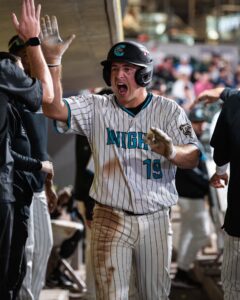Top 30 White Sox prospects midseason 2019
Twice a year, FutureSox writers work together to produce a ranked list of the top 30 White Sox prospects. We use a voting system among the staff, then argue out specific players and rankings until we come to a final list.
We release the list in two parts. Previously was the group ranked 16-30. This is the full list of top 30 prospects.
ELIGIBILITY: We consider a “prospect” any player in the White Sox organization who has not yet achieved MLB rookie status.
THE LIST
1. Luis Robert, OF (Previous: 4, +3)
- Signed from Cuba in 2017
After signing for $26 million in 2017, Robert is living up to the hype in 2019. He has emerged as one of the top prospects in baseball. After a successful stint in the Arizona Fall League, Robert was given a very conservative assignment to Winston-Salem to start 2019. He put up a 1.432 OPS in 19 games, which was a sign of things to come for the rest of his year. Robert slowed somewhat in AA Birmingham, but still was extremely productive. In 56 games he hit .314/.362/.518 and had 21 stolen bases in 27 attempts. The White Sox moved him up again, thinking AAA pitchers could mix up their approach and throw Robert off. In reality, Robert gets to play with the same ball that has led to a power surge in the majors and went from a pitchers’ park in Birmingham to a hitters’ park in Charlotte. He has shown off all five tools in his time in AAA with an OPS well north of 1.000 and a number of highlights in the field and on the basepaths. Robert is major league ready and will give the White Sox another cornerstone player in 2020.
2. Michael Kopech, RH SP (Previous: 2)
- Drafted 1st Round Supplemental (33rd overall) in 2014 by Red Sox, acquired via trade Dec. 2016
Nothing has changed for Kopech since our preseason list. He is still rehabbing from Tommy John surgery and is still expecting back in 2020. He will be on our preseason list, but that should be the last of Kopech on prospect rankings.
3. Dylan Cease, RH SP (Previous: 3)
- Drafted 6th round in 2014 by Cubs, acquired via trade July 2017
After tearing up Winston-Salem and Birmingham last year, Cease started the year in Charlotte and seemed to be recreating that success. Through May, he had a 3.18 ERA with 59 strikeouts and 20 walks in 51 innings. Things got ugly in June with an 8.31 ERA, 14 K, 12 BB in 17.1 IP in five starts. Still, the White Sox thought it was time to bring him up. A lack of fastball command has cost him in the majors just like it was in AAA before he was called up. His premium slider and quality curveball have still been effective, but he is chasing from behind far too often. If Cease can harness his fastball, which sits 96-97 and can hit 98 with some regularity, he will be a successful big league pitcher. Expect this to be the last time you see him on one of our lists. Unless something goes terribly wrong, he should hit the 50 inning threshold before end of the season.
4. Andrew Vaughn, 1B (New; 2019 draft)
- Drafted 1st Round (3rd overall) in 2019
Vaughn is a premier bat that has already moved quickly through the minors and is expected to continue to do so. Any question about his profile as a right-handed hitting first baseman is typically nullified by the fact that most scouts and analysts expect his bat to be plus for years. Vaughn has already moved up to Winston-Salem and homered in his first game there. A 2020 ETA in the majors seems aggressive, but if he’s on fire, the White Sox are in contention and could use another first base/DH bat, Vaughn could join up. Otherwise, expect a 2021 debut.
5. Nick Madrigal, 2B (Previous: 5)
- Drafted 1st Round (4th overall) in 2018
Madrigal had a slow start to 2019, which caused plenty of consternation about his profile as an empty average hitter. The White Sox saw enough improvement to move him up to Birmingham in early June and he thrived in AA. Madrigal hit .341/.400/.451 with 14 steals in 20 attempts to earn another promotion. The hitting conditions of Charlotte/AAA will be an interesting environment. Can Madrigal show a little more power? Even if he doesn’t, his absurdly low strikeout rate should allow him to compete with his bat at the major league level in 2020. Throw in plus defense and decent speed and Madrigal should be a solid regular for years.
6. Dane Dunning, RH SP (Previous: 6)
- Drafted 1st Round Supplemental (29th overall) in 2016 by Nationals, acquired via trade Dec. 2016
An arm injury ended Dunning’s season last June. That led to Tommy John surgery, which ended his 2019 before it began. He appeared to have mastered AA in 2018 with a 2.76 ERA, 69 K and 23 BB in 62 innings over 11 starts. Given the time off, the White Sox probably won’t send him to AAA to start 2020. He still has the stuff and track record in the minors to believe he can be a solid big league starter. The question going forward will be his health and how he can handle a big league work load in the future.
7. Steele Walker, OF (Previous: 15, +8)
- Drafted 2nd Round in 2018
After seeing a number of other outfield prospects succeed in Winston-Salem last year and then flop in Birmingham this year, Walker comes out on top among that group. Should he have? He hasn’t exactly set the world on fire with the Dash. However, he hasn’t failed like Blake Rutherford and Luis Gonzalez and hasn’t dealt with significant injuries like Micker Adolfo and Luis Alexander Basabe. He has shown a decent walk rate and solid contact rate with average power. He doesn’t have a top tier profile, but doesn’t have any glaring weaknesses in his game.
8. Zack Collins, C (Previous: 8)
- Drafted 1st Round (10th overall) in 2016
Collins is the epitome of modern power bats. He walks a ton, hits for big power and strikes out a ton. He pushed the extreme in 2018 in terms of strikeouts when he was in AA and raised major red flags. He showed improvement in AAA and earned a big league call-up in June. He homered in his first MLB start, but finished 2-for-26 in a strange stint with the White Sox. He wasn’t given consistent playing time and struggled with what he was given. James McCann’s emergence combined with Collins’ struggles in the majors create questions about his future, but it’s too early to write him off.
9. Jonathan Stiever, RH SP (Previous: 28, +19)
- Drafted 5th Round in 2018
Stiever is unquestionably the breakout prospect of the White Sox minor leagues this year. He was on our radar entering the year, cracking the top 30 at 28, but we didn’t see this coming. As a fifth-round pick, Stiever had some attention on him and he has blown that wide open. The former Indiana Hoosier was solid, but unspectacular in Kannapolis to start the year. He struck out 77 and walked just 14 in 74 innings, but he gave up 88 hits and had a 4.74 ERA. The White Sox still thought to move him up to Winston-Salem in mid-June and he took off. A tick up in his fastball to the mid-90s and a change in his approach (using his four-seamer up in the zone and having his offspeed stuff play off that) has led to dominance in the Carolina League. He has a 2.52 ERA with 60 strikeouts and nine walks in 50 innings. He currently profiles as a mid-rotation starter.
10. Blake Rutherford, OF (Previous: 11, +1)
- Drafted 1st round (18th overall) in 2016 by Yankees, acquired via trade July 2017
As with Collins a couple places above, Rutherford has been a bit of a puzzle as well. Collins has question marks with his contact rate and defensive ability while Rutherford has question marks with his power and bat in general. In nearly three years of full season ball, Rutherford has yet to show plus power. He offered hope last year in Winston-Salem with a .781 OPS, but even that was just approaching average power. This season has not gone as well. Rutherford posted a sub-.600 OPS in both April and May before a hot streak in June offered some hope. The timing of his hot month may have biased a few of our voters. Rutherford hit .365/.400/.471 for the Barons in June, but even that showed a low walk rate and an ISO barely above .100. On top of that he slumped in July.
11. Micker Adolfo, OF (Previous: 7, -4)
- Signed from Dominican Republic in 2013
Adolfo offered hope in 79 games with Winston-Salem last year. He was on his way back from Tommy John surgery and was limited to DH. He started 2019 in Birmingham, but struggled in 23 games and then had season-ending surgery on his elbow. Whether or not the injury was affecting his hitting, Adolfo was drawing plenty of walks (14 in 95 PA), but striking out at an alarming rate (37.9%) while also not hitting for as much power as we’ve gotten accustomed to. When healthy, Adolfo still has among the highest upsides in the system.
12. Luis Alexander Basabe, OF (Previous: 9, -3)
- Signed from Venezuela in 2012 by Red Sox, acquired via trade Dec. 2016
A broken hamate bone in his left hand cost Basabe most of April and created question marks about how it was affecting his swing even after he came back. After posting a .251/.340/.394 line in 61 games in Birmingham last year, Basabe hasn’t even matched those numbers this season. He had a brutal start to the season with a .600 OPS at the end of the first half. Since then, in an admittedly smaller sample size, Basabe has hit .302/.375/.413 in 18 games. The lack of power is most surprising considering he had a .187 ISO in 2018. Is he feeling lingering effects of the injury? His profile as a solid defensive corner outfielder with a strong arm, decent power and a good walk rate is still enticing if he can show his early season slump was a fluke.
13. Andrew Dalquist, RH SP (New; 2019 draft)
- Drafted 3rd Round in 2019
Dalquist hasn’t pitched as a pro yet so we had to rely on his draft profile as far as ranking him. The White Sox gave him a $2 million signing bonus out of high school to pry him away from a commitment to Arizona. He has a low-to-mid 90s fastball and scouts seem to think he has the profile to add velocity as he fills out. His curve is the next best pitch in his arsenal, but his offspeed stuff is still raw.
14. Luis Gonzalez, OF (Previous: 10, -4)
- Drafted 3rd Round in 2017
Gonzalez showed a decent walk rate, good power and a good contact rate at both levels of A ball in 2018. That led to his stock surging upwards. The transition to AA, as has been the case for a number of White Sox prospects this year, has not gone as well. His walk and strikeout rates are similar to last year, but his ISO has dipped from .191 to .116 and his BABIP has also taken a hit. On the upside, similar to Basabe, his numbers have been better in the second half (.278/.342/.431) as opposed to the first half (.230/.288/.324). Gonzalez profiles as a well-rounded player without any significant plus tools (his arm is his best tool).
15. Matthew Thompson, RH SP (New; 2019 draft)
- Drafted 2nd Round in 2019
As with Dalquist, the White Sox haven’t had Thompson pitch yet in the pros. His low 90s fastball is his best pitch, but his curve has been a plus pitch when on. He got knocked for losing some of his stuff in his senior season in high school after profiling as a first-rounder as a junior. The White Sox figured they could get him back to his best and refine the rest of his arsenal. Thompson signed for $2.1 million.
16. Gavin Sheets, 1B (Previous: 28, +12)
17. Yolbert Sanchez, SS (New; international signing)
18. Konnor Pilkington, LH SP (Previous: 24, +6)
19. Tyler Johnson, RH RP (Previous: 20, +1)
20. Jimmy Lambert, RH SP (Previous: 22, +2)
21. Bernardo Flores, LH SP (Previous: 23, +2)
22. James Beard, OF (New; 2019 draft)
23. Jake Burger, 3B (Previous: 14, -9)
24. Alec Hansen, RH RP (Previous: 12, -12)
25. Zack Burdi, RH RP (Previous: 13, -12)
26. Ian Hamilton, RH RP (Previous: 17, -9)
27. Bryce Bush, OF (Previous: 21, -6)
28. Lenyn Sosa, SS (Previous: 26, -2)
29. DJ Gladney, 3B (New; 2019 draft)
30. Jose Rodriguez, SS (New)





